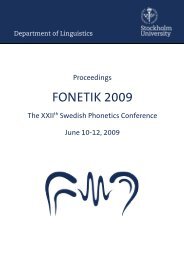Pronunciation variation modelling using decision tree induction from ...
Pronunciation variation modelling using decision tree induction from ...
Pronunciation variation modelling using decision tree induction from ...
Create successful ePaper yourself
Turn your PDF publications into a flip-book with our unique Google optimized e-Paper software.
Proceedings, FONETIK 2004, Dept. of Linguistics, Stockholm University<br />
<strong>Pronunciation</strong> in context is modelled in relation<br />
to an automatically supplied canonical<br />
reference transcription and thus all annotation<br />
is aligned to canonical transcriptions, creating<br />
one data point per canonical segment.<br />
Information<br />
Information is provided at five levels of description,<br />
corresponding to linguistic units of<br />
different sizes. At the utterance level, speaker<br />
gender information is provided. The annotation<br />
at the phrase level consists of phrase type tags<br />
and some different measures of phrase length<br />
and phrase prosodic weight.<br />
The word level annotation consists of measures<br />
of word length, part of speech tags, word<br />
type information (function or content), estimations<br />
of global word frequencies weighted with<br />
collocation weights and the number of full form<br />
word and lexeme repetitions thus far in the discourse.<br />
Also supplied is information about the<br />
position of a word in the current phrase and in a<br />
collocation, information about focal stress, estimated<br />
word mean relative speech rate and information<br />
about adjacent hesitation sounds,<br />
word fragments and prosodic boundaries.<br />
The annotation at the syllable level consists<br />
of information about syllable length, the position<br />
of the syllable in the word, the nucleus of<br />
the syllable, word stress, stress type and the estimated<br />
relative speech rate of the syllable.<br />
At the segment level, the annotation includes<br />
the identity of the canonical segment, a<br />
set of articulatory features describing the canonical<br />
segment and the position of the segment<br />
in the syllable (onset, nucleus or coda).<br />
There is also information about the position of<br />
a segment in a cluster and about the length of<br />
the current cluster. Finally, the identity of the<br />
detailed segment is included. The detailed segment<br />
identities are determined automatically<br />
and will need manual correction. However, the<br />
initial tests of <strong>decision</strong> <strong>tree</strong> inducers were conducted<br />
<strong>using</strong> the uncorrected transcriptions.<br />
Annotation Resources<br />
Canonical (signal independent) phonological<br />
transcriptions of the words in the database are<br />
produced by a system for automatic timealigned<br />
phonetic transcription developed by<br />
Sjölander (2003), adapted to be able to use<br />
manually determined word boundaries.<br />
A net describing tentative detailed (signal<br />
dependent) transcriptions is generated <strong>using</strong> a<br />
list of possible detailed realisations for each<br />
canonical segment. Segment HMMs and alignment<br />
tools developed by Sjölander (2003) are<br />
used for finding the detailed transcription with<br />
the optimal match to the signal. The detailed<br />
transcriptions are aligned to the canonical transcriptions<br />
<strong>using</strong> null symbols as placeholders<br />
for deleted segments.<br />
Global word frequencies and collocation<br />
weights were estimated <strong>using</strong> the Göteborg<br />
Spoken Language Corpus (cf. e.g. Allwood,<br />
1999), including roughly three million words of<br />
orthographically transcribed spoken language<br />
<strong>from</strong> different communicative situations.<br />
The TnT tagger (Brants, 2000) trained on<br />
Swedish text (Megyesi, 2002) is used for part<br />
of speech tagging and the SPARK-0.6.1 parser<br />
(Aycock, 1998), with a context free grammar<br />
for Swedish written by Megyesi (2002) is used<br />
for chunking the transcribed and part of speech<br />
tagged orthographic transcriptions into phrase<br />
units.<br />
Decision Tree Induction<br />
For data-driven development of pronunciation<br />
<strong>variation</strong> models, machine learning methods of<br />
some type are necessary. For developmental<br />
purposes, it is preferred that the model can be<br />
represented on a human-understandable format.<br />
The <strong>decision</strong> <strong>tree</strong> <strong>induction</strong> paradigm is used to<br />
induce models on a <strong>tree</strong> format and the <strong>tree</strong><br />
structures can be converted into humanreadable<br />
rules.<br />
A <strong>decision</strong> <strong>tree</strong> classifier is used to classify<br />
instances based on their sets of description parameters.<br />
In most cases, <strong>decision</strong> <strong>tree</strong> learning<br />
algorithms induce <strong>tree</strong> structures <strong>from</strong> data employing<br />
a best split first tactic. This means that<br />
the parameter used for splitting the data set at<br />
each node is the one that divides the set into the<br />
most separate groups (as determined e.g. by<br />
some entropy-based measure).<br />
Decision Tree Learning Algorithms<br />
Some freely available, open source <strong>decision</strong><br />
<strong>tree</strong> learner implementations based on or similar<br />
to the C4.5 algorithm (Quinlan, 1993) were<br />
tested. The same training and test data (although<br />
on different formats for the different<br />
implementations) were used in each case. The<br />
C4.5 default splitting criterion (Gain Ratio) and<br />
settings for pruning (confidence level pruning<br />
with a confidence level of 0.25) were also used<br />
in each case. Each implementation offers its<br />
own optimisation options and the results re-

















